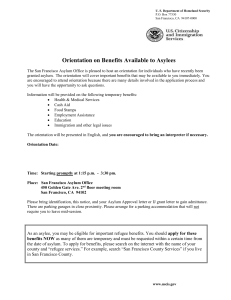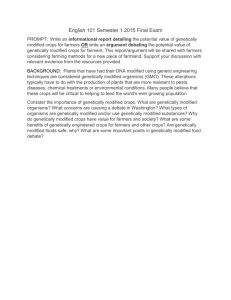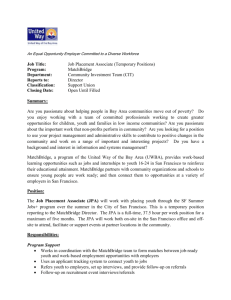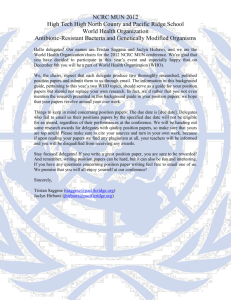Agricultural Antibiotics: Abuse in the Industry Leading to Crisis Stage
advertisement
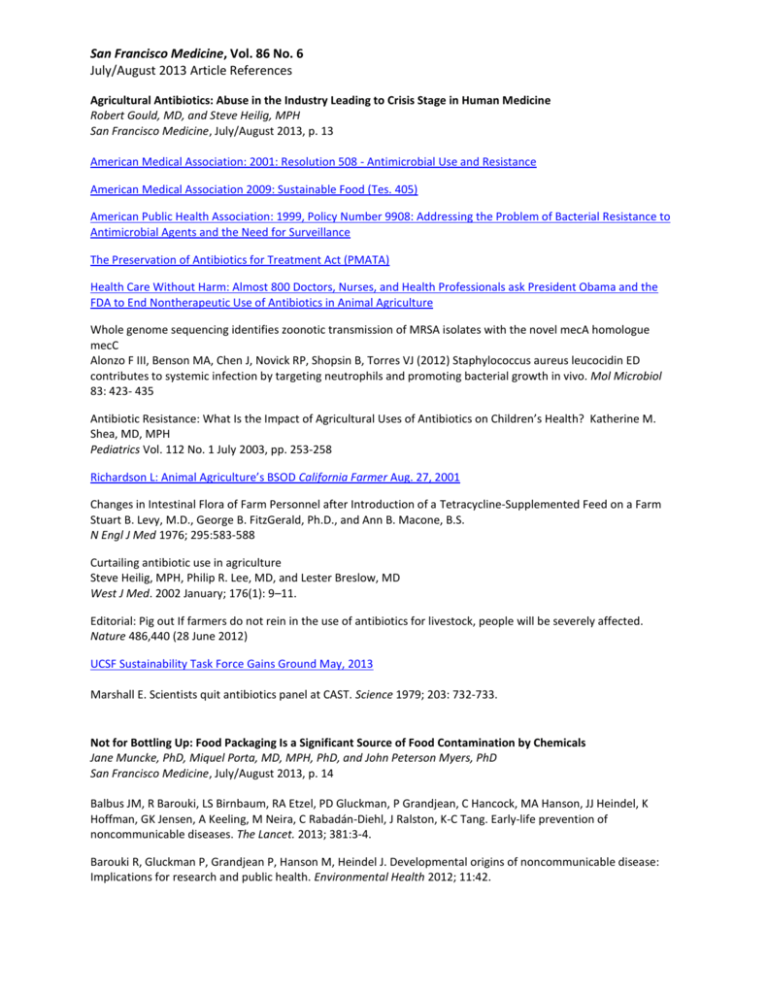
San Francisco Medicine, Vol. 86 No. 6 July/August 2013 Article References Agricultural Antibiotics: Abuse in the Industry Leading to Crisis Stage in Human Medicine Robert Gould, MD, and Steve Heilig, MPH San Francisco Medicine, July/August 2013, p. 13 American Medical Association: 2001: Resolution 508 - Antimicrobial Use and Resistance American Medical Association 2009: Sustainable Food (Tes. 405) American Public Health Association: 1999, Policy Number 9908: Addressing the Problem of Bacterial Resistance to Antimicrobial Agents and the Need for Surveillance The Preservation of Antibiotics for Treatment Act (PMATA) Health Care Without Harm: Almost 800 Doctors, Nurses, and Health Professionals ask President Obama and the FDA to End Nontherapeutic Use of Antibiotics in Animal Agriculture Whole genome sequencing identifies zoonotic transmission of MRSA isolates with the novel mecA homologue mecC Alonzo F III, Benson MA, Chen J, Novick RP, Shopsin B, Torres VJ (2012) Staphylococcus aureus leucocidin ED contributes to systemic infection by targeting neutrophils and promoting bacterial growth in vivo. Mol Microbiol 83: 423- 435 Antibiotic Resistance: What Is the Impact of Agricultural Uses of Antibiotics on Children’s Health? Katherine M. Shea, MD, MPH Pediatrics Vol. 112 No. 1 July 2003, pp. 253-258 Richardson L: Animal Agriculture’s BSOD California Farmer Aug. 27, 2001 Changes in Intestinal Flora of Farm Personnel after Introduction of a Tetracycline-Supplemented Feed on a Farm Stuart B. Levy, M.D., George B. FitzGerald, Ph.D., and Ann B. Macone, B.S. N Engl J Med 1976; 295:583-588 Curtailing antibiotic use in agriculture Steve Heilig, MPH, Philip R. Lee, MD, and Lester Breslow, MD West J Med. 2002 January; 176(1): 9–11. Editorial: Pig out If farmers do not rein in the use of antibiotics for livestock, people will be severely affected. Nature 486,440 (28 June 2012) UCSF Sustainability Task Force Gains Ground May, 2013 Marshall E. Scientists quit antibiotics panel at CAST. Science 1979; 203: 732-733. Not for Bottling Up: Food Packaging Is a Significant Source of Food Contamination by Chemicals Jane Muncke, PhD, Miquel Porta, MD, MPH, PhD, and John Peterson Myers, PhD San Francisco Medicine, July/August 2013, p. 14 Balbus JM, R Barouki, LS Birnbaum, RA Etzel, PD Gluckman, P Grandjean, C Hancock, MA Hanson, JJ Heindel, K Hoffman, GK Jensen, A Keeling, M Neira, C Rabadán-Diehl, J Ralston, K-C Tang. Early-life prevention of noncommunicable diseases. The Lancet. 2013; 381:3-4. Barouki R, Gluckman P, Grandjean P, Hanson M, Heindel J. Developmental origins of noncommunicable disease: Implications for research and public health. Environmental Health 2012; 11:42. San Francisco Medicine, Vol. 86 No. 6 July/August 2013 Article References Biedermann M, Ingenhoff J-E, Zurfluh M, Richter L, Simat T, Harling A et al. Migration of mineral oil, photoinitiators, and plasticizers from recycled paperboard into dry foods: A study under controlled conditions. Food Additives & Contaminants: Part A. 2013; online May 8, 2013. Bradley E, Coulier L. An investigation into the reaction and breakdown products from starting substances used to produce food contact plastics. 2007; FD 07/01. London: Central Science Laboratory. Grob K, Biedermann M, Scherbaum E, Roth M, Rieger K. Food contamination with organic materials in perspective: Packaging materials as the largest and least controlled source? A view focusing on the European situation. Critical Reviews in Food Science and Nutrition. 2006; 46:529-535. Kortenkamp A, Faust M. Combined exposures to anti-androgenic chemicals: Steps towards cumulative risk assessment. International Journal of Andrology. 2010; 33:463-474. Maffini, MV, Alger HM, Olson ED, Neltner TG. Looking back to look forward: A review of FDA’s food additives safety assessment and recommendations for modernizing its program. 2013; in press. Neltner TG, NR Kulkarni, HM Alger, MV Maffini, ED Bongard, ND Fortin, ED Olson. Navigating the U.S. food additive regulatory program. Comprehensive Reviews in Food Science and Food Safety. 2011; 10:342-368. Rudel RA, Gray JM, Engel CL, Rawsthorne TW, Dodson RE, Ackerman JM et al. Food packaging and bisphenol A and bis(2-ethyhexyl) phthalate exposure: Findings from a dietary intervention. Environmental Health Perspectives. 2011; 119:914-920. Soto, AM, C Brisken, C Schaeberle, C Sonnenschein. Does cancer start in the womb? Altered mammary gland development and predisposition to breast cancer due to in utero exposure to endocrine disruptors. Journal of Mammary Gland Biology and Neoplasia. 2013; DOI 10.1007/s10911-013-9293-5 (not yet active). Vandenberg LN, Colborn T, Hayes TB, Heindel JJ, Jacobs DR, Lee DH, Shioda T, Soto AM, vom Saal FS, Welshons WV, Zoeller RT, Myers JP. Hormones and endocrine disrupting chemicals: Low-dose effects and nonmonotonic dose response. Endocrine Reviews. 2012; 33:378-455 http://bit.ly/A25AWs DOI: 10.1210/er.2011-1050. Genetically Modified Food: Fantastic or “Frankenfood”? The Labeling Debate Steve Heilig, MPH and Ted Schettler, MD San Francisco Medicine, July/August 2013, p. 16 USDA says more review needed for new Monsanto, Dow GMO crops. Reuters, May 10, 2013 American Bar Association; summary of FDA requirements for GM food. Impacts of genetically engineered crops on pesticide use in the U.S. – the first sixteen years Charles M Benbrook Environmental Sciences Europe 2012, 24:24 United Nations Environment Programme: Agriculture at a Crossroads GM Crops: Promise and Reality Modifying the Endless Debate Over Genetically Modified Crops By Bryan Walsh TIME, May 14, 2013 Biotech crops risky to consume, says former pro-GMO scientist 20 May 2013 18:06 Marvyn N. Benaning GMO Myths and Truths San Francisco Medicine, Vol. 86 No. 6 July/August 2013 Article References Impact of Genetically Engineered Crops on Farm Sustainability in the United States National Academy of Sciences, 2010 The pro-GM lobby's seven sins against science Peter Melchett 17 December 2012 Hematotoxicity of Bacillus thuringiensisas Spore-crystal Strains Cry1Aa, Cry1Ab, Cry1Ac or Cry2Aa in Swiss Albino Mice Mezzomo et al., J Hematol Thromb Dis 2013, 1:1 http://dx.doi.org/10.4172/jhtd.1000104 Volume 1 • Issue 1 • 1000104 FDA statement: Genetically Engineered Foods James H. Maryanski, Ph.D October 19, 1999 Pesticides Make a Comback Many Corn Farmers Go Back to Using Chemicals as Mother Nature Outwits Genetically Modified Seeds Wall St. J. May 21, 2013 Childhood Obesity: Where Does the United States Stand and What Can We Do? Sally S. Wong, PhD, RD, CDN San Francisco Medicine, July/August 2013, p. 20 1. American Heart Association. Overweight in children. 2. Dietary sugars intake and cardiovascular health. Circulation. AHA scientific statement. 3. The Institute of Medicine. Dietary reference for energy, carbohydrate, fiber, fat, fatty acids, cholesterol, protein, and amino acids. 4. Department of Health and Mental Hygiene. Childhood obesity is a serious concern in New York City. 2009. 5. NYS Comptroller DiNapoli. Preventing and reducing childhood obesity in New York. 6. Alliance for a Healthier Generation. Healthier School Foods and Beverages.


